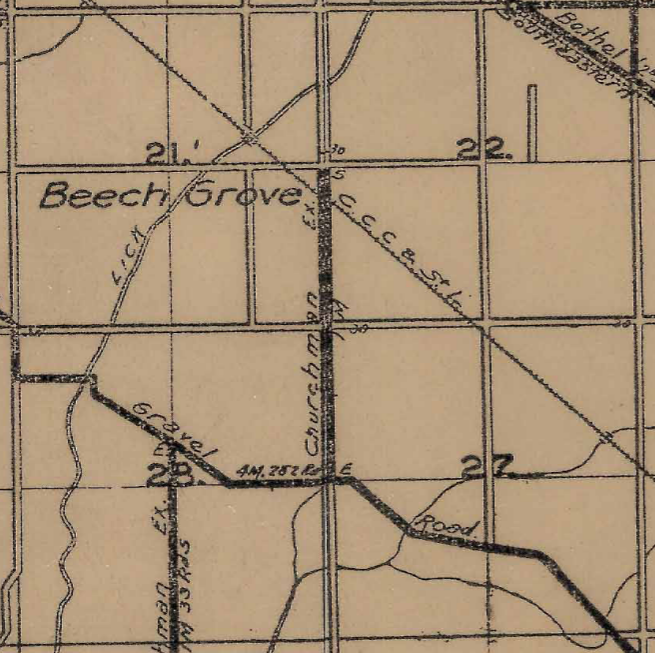As I have covered much of Marion County when it comes to the little towns that have crept up due to the transportation facilities in Pike Township. For all intents and purposes, there really are only three places that could be mentioned here: Augusta; New Augusta; and Traders Point.

Let’s start with Augusta. This town was created along the Michigan Road in 1832. It had been platted by David G. Boardman. Naming of the town has never been determined with any certainty. But it would lead to the creation of the Augusta Gravel Road Company, a toll road using the old Michigan Road right-of-way.
The original plan of the town included basically two blocks paralleling the Michigan Road centered on what was called Meridian Street (now 77th Street). The backing streets that were parallel to the Michigan Road were called Spring St. (now Spring Lane) and Parallel Street.
The southern most street of the original plat was Walnut Street. This, today, is called 76th Street. The cemetery shown in the map image to the left is still there. It is located on the curve of 76th Street as it leaves the town itself.
The town of Augusta grew slowly, providing services to local residents and travelers along the Michigan Road. Stagnation occurred when the Indianapolis & Lafayette Railroad was built through the area, located about a mile or so west of the town. This would create the second town I want to cover.

The Indianapolis & Lafayette Railroad built, in 1852, what would be called by the railroad “Augusta Station.” It would be the closest location to the town of Augusta above. The station was located just north of the survey line that would later become 71st Street.
The old town of Augusta found itself in a strange situation. Between the railroad and the fact that the Michigan Road became a toll road (The Augusta Gravel Road), within a few years, a town grew up around the station. There were two names for the village came to be used – Augusta Station and Hosbrook. In 1878, the United States Postal Service decided the issue of the town name. The post office was given the name New Augusta.

West of both Augusta and New Augusta is Traders Point. Or, more to the point, more or less was, Traders Point. The original town sprang up around the mill built by John Jennings and Josiah Coughran in 1864. It was located along Eagle Creek where it was crossed by the old Indianapolis-Lafayette Road. The origin of the name is unclear. There are stories about it having been the location of a Native American trading post. It could also have been named simply because it was a convenient place to do business.
With the coming of the Auto Trail era, all three towns would be included. Traders Point and New Augusta would be included on the Hoosier Motor Club’s Dandy Trail, an 88 mile circle around Marion County. It would skirt Augusta to the south, having been run along the 71st Street/Westlane Road corridor through the area. Augusta would once again appear on the Michigan Road, this time the Auto Trail, that mostly covered the same roads as the original Michigan Road built in the 1830’s. Traders Point would also was on the Jackson Highway.
In 1919, with the creation of the Indiana State Highway Commission, the Jackson Highway north from Indianapolis became part of State Road 6. Later, the old Michigan Road, at least from Indianapolis to Logansport, would become part of State Road 15. SR 6, at least through Traders Point, would be changed to US 52, and SR 15 would changed to SR 29, when the Great Renumbering happened on 1 October 1926. New Augusta would find itself left off of the state highway system all together.
Traders Point would cease to exist as it was originally planned with the coming of Eagle Creek Reservoir in the 1960’s. The town was determined to be on the flood plain for the new man made lake. The location isn’t under water now, and visiting there has very little in the way of sights. The name Traders Point has been placed on quite a few things removed from the original town. Even on shopping centers miles away at 86th Street and I-465.
New Augusta would find itself removed from most of the commercial building craze of the 1950’s and 1960’s. Augusta would get those facilities as shopping centers and the like were built along Michigan Road. The railroad tracks that helped create New Augusta are still in place, but no longer connect to any towns north of New Augusta. They now connect to industrial park areas near 79th and 86th Streets, connecting to the Park 100 area.
All three areas of the county would be absorbed into the City of Indianapolis when UniGov went into effect. Neither Augusta nor Traders Point appear on the Indiana State Highway system, with Traders Point being the first to be removed since US 52 was the first state road in Marion County to be detoured around on Interstate 465.


































